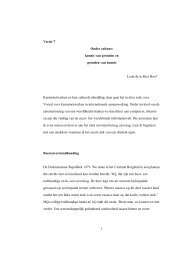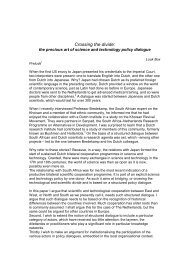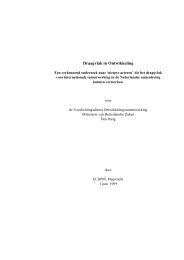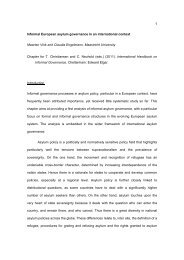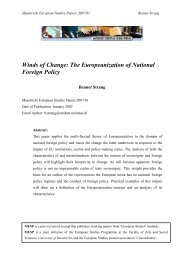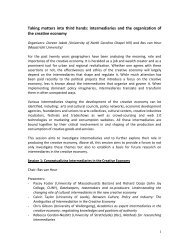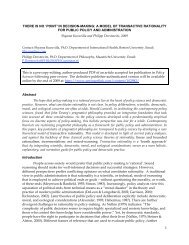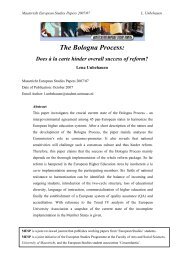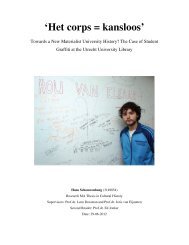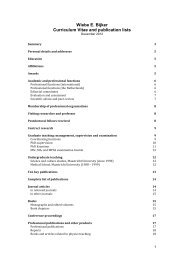the case of the synthetic dye industry, 1857–1914 - Maastricht ...
the case of the synthetic dye industry, 1857–1914 - Maastricht ...
the case of the synthetic dye industry, 1857–1914 - Maastricht ...
You also want an ePaper? Increase the reach of your titles
YUMPU automatically turns print PDFs into web optimized ePapers that Google loves.
194 J.P. Murmann and E. Homburg<br />
<strong>the</strong> U.S. The U.S. was simply not included in this important network through<br />
which <strong>the</strong> early aniline <strong>dye</strong> knowledge was transmitted (Homburg, 1983). Second,<br />
and less significantly, 16 <strong>the</strong> U.S. did not possess a large number <strong>of</strong> people who<br />
had <strong>the</strong> skills to start production <strong>of</strong> organic intermediate chemicals or syn<strong>the</strong>tic<br />
<strong>dye</strong>s. Without organic intermediates, <strong>dye</strong> production was not possible unless<br />
entrepreneurs imported intermediates from Europe.<br />
Pattern 2: France most likely experienced <strong>the</strong> largest amount <strong>of</strong> entry in<br />
<strong>the</strong> early years because <strong>of</strong> <strong>the</strong> very three factors that were absent in <strong>the</strong> U.S.<br />
Most importantly, as home <strong>of</strong> <strong>the</strong> largest market for luxury textiles, <strong>the</strong> highest<br />
demand for <strong>the</strong> initially very expensive syn<strong>the</strong>tic <strong>dye</strong>s occurred in France. Many<br />
entrepreneurs decided to enter <strong>the</strong> market when <strong>the</strong>y saw how large <strong>the</strong> demand<br />
for Perkin’s aniline purple was in France (Homburg, 1983). The perceived size <strong>of</strong><br />
<strong>the</strong> French market acted as an inducement for potential entrepreneurs. Secondly,<br />
before 1857, an infrastructure <strong>of</strong> organic intermediate producers existed in France<br />
who supplied producers <strong>of</strong> perfumes and semi-syn<strong>the</strong>tic <strong>dye</strong>s sold on <strong>the</strong> luxury<br />
market (Chateau, 1868). 17 These intermediate producers had experience that <strong>the</strong>y<br />
could use to integrate forward into syn<strong>the</strong>tic <strong>dye</strong> production or, alternatively, to<br />
produce and sell <strong>dye</strong> intermediates to newly formed syn<strong>the</strong>tic <strong>dye</strong> companies.<br />
Thirdly, besides a developed market for intermediates, France possessed two<br />
important centers <strong>of</strong> chemistry, one in Paris and one in Lyon. Pelouze’s laboratory<br />
in Paris trained students who subsequently founded many <strong>of</strong> <strong>the</strong> syn<strong>the</strong>tic <strong>dye</strong><br />
firms around <strong>the</strong> city (Travis, 1993, pp. 149-150, pp. 71–72, p. 79).<br />
Pattern 3: Why was <strong>the</strong> entry rate in <strong>the</strong> early years higher in Germany than in<br />
Britain even though Germany’s textile <strong>industry</strong> was about 23 times smaller than<br />
that <strong>of</strong> Britain? The most important reason seems to lie in <strong>the</strong> patent system. In<br />
Britain <strong>dye</strong>s were protected by patents, whereas in Germany no such protection<br />
existed because <strong>the</strong> customs union (Zollverein) eliminated any effective patent<br />
protection. 18 This meant that anyone who wished to enter <strong>the</strong> syn<strong>the</strong>tic <strong>dye</strong><br />
business in Germany could do so. But in Great Britain entry into <strong>the</strong> <strong>dye</strong> business<br />
was severely restricted because, starting with Perkin’s aniline purple, many <strong>of</strong><br />
<strong>the</strong> syn<strong>the</strong>tic <strong>dye</strong>s were under patent protection.<br />
Pattern 4: Why did German <strong>industry</strong> participation continue to increase after<br />
<strong>the</strong> mid 1860s, contrary to <strong>the</strong> developments in France and Britain? Again <strong>the</strong><br />
patent legislation seems to have made all <strong>the</strong> difference. Because patent protection<br />
was not available in Germany until unification and <strong>the</strong> creation <strong>of</strong> an<br />
16 Skills in organic chemistry were much less important in this early phase. We came to this<br />
conclusion in part by studying <strong>the</strong> question <strong>of</strong> why a syn<strong>the</strong>tic <strong>dye</strong> <strong>industry</strong> did not emerge in <strong>the</strong><br />
Ne<strong>the</strong>rlands in <strong>the</strong> 1860s. There was some <strong>of</strong> knowledge <strong>of</strong> organic chemistry in <strong>the</strong> Ne<strong>the</strong>rlands, but<br />
virtually no silk <strong>dye</strong>ing or o<strong>the</strong>r production activity for <strong>the</strong> luxury textile market. The Dutch textile<br />
firms were isolated from <strong>the</strong> leading textile producers abroad and hence did not learn about <strong>the</strong> new<br />
<strong>dye</strong>s as quickly.<br />
17 A semi-syn<strong>the</strong>tic <strong>dye</strong> such as murexide involved in its manufacture and application both <strong>the</strong><br />
traditional natural <strong>dye</strong> extraction techniques as well as syn<strong>the</strong>tic chemical procedures. See Homburg<br />
(1983) for details.<br />
18 A special article (an 1842 addition) in <strong>the</strong> Zollverein (customs union) agreement did allow <strong>the</strong><br />
member states to grant patents in <strong>the</strong>ir territories, but forbade members to prevent producers in o<strong>the</strong>r<br />
member states from selling <strong>the</strong> product in all member states (Penrose, 1951, p. 14; Heggen, 1975).



